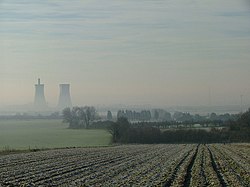Ebbsfleet, Thanet
| Ebbsfleet | |
|---|---|
 Farmland at Ebbsfleet, with Richborough Power Station in the distance (prior to the demolition of the towers) |
|
| Ebbsfleet shown within Kent | |
| OS grid reference | TR333631 |
| Civil parish | |
| District | |
| Shire county | |
| Region | |
| Country | England |
| Sovereign state | United Kingdom |
| Post town | RAMSGATE |
| Postcode district | CT12 |
| Police | Kent |
| Fire | Kent |
| Ambulance | South East Coast |
| EU Parliament | South East England |
| UK Parliament | |
Ebbsfleet is a hamlet near Ramsgate, Kent, at the head of Pegwell Bay. Historically it was a peninsula on the southern coast of the Isle of Thanet, marking the eastern end of the Wantsum Channel that separated Thanet from the Kentish mainland. It is in the civil parish of Minster-in-Thanet
Since Pegwell Bay was a natural harbour on the part of the coast nearest to the Continent, Ebbsfleet is said to have been the site of two important arrivals in English history: Hengist and Horsa in 449 AD, who led the English in their conquest of Britain; and Augustine of Canterbury in 597 AD, who converted the English to Christianity.
Ebbsfleet is the titular see of the Bishop of Ebbsfleet, an episcopal visitor for the Province of Canterbury.
Ebbsfleet Lane marks the line of the peninsula today. The Wantsum Channel silted up and was reclaimed in the 15th century; all that remains of it is the channel of the River Stour, which enters the sea by Richborough Power Station. There are a couple of houses and Ebbsfleet House at Stonelees, where Ebbsfleet Lane meets the Sandwich road, and Ebbsfleet Farm on the hill behind.
There are prehistoric, Iron Age, Roman, and Saxon settlement remains on the peninsula around Ebbsfleet Farm, which may have also been the landing stage for the Roman ferry across the channel to Richborough. Claudius landed his army at Richborough on the other side of the channel, to start his invasion of 43 AD, and it became a major port of Roman Britain.
According to the Anglo-Saxon Chronicle it is also the site of the landings made by the English in the fifth century AD; an entry states that Hengist and Horsa, on the invitation of Vortigern, King of the Britons, landed in 449 at Eopwinesfleot, usually assumed to be Ebbsfleet. A fleot is a creek and Eopwine is a Germanic personal name; the modern Ebbsfleet may have developed from Eoppa/Eobba, a short form of this name. There is the common sense possible alternative derivation from the Old English 'ebbian' , to move away from (of West Germanic source) describing the twice daily phenomenon of all the water in the Wantsum channel 'moving away' from land at this outlet to the sea. The arrival of the English is commemorated by a monument and replica longship up the coast at Cliffsend. The Battle of Wippedesfleot between the Britons and the English in 465 is thought to have taken place at Ebbsfleet.
...
Wikipedia

